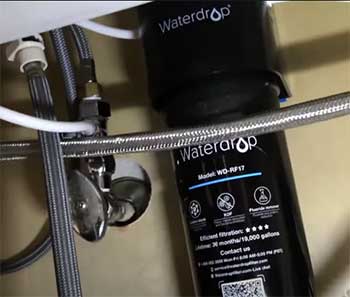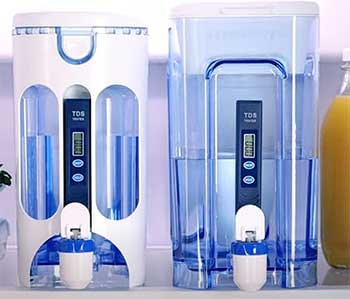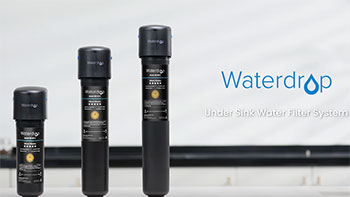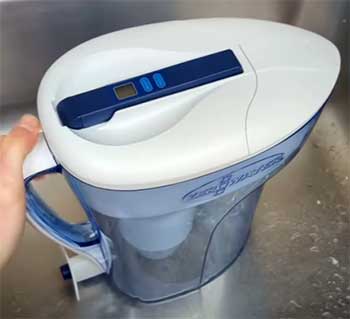Clean, filtered water is essential for good health. Filtering your tap water removes contaminants like lead, chlorine, mercury, asbestos fibers, pharmaceutical drugs, pesticides, and fluoride. Filtered water simply tastes better too!
Waterdrop and ZeroWater are two of the most popular pitcher-style water filters on the market. But they use different filtration technologies and have some key differences.
We’ll compare the filtration effectiveness, taste, price, certifications, and other factors to help you choose if Waterdrop or ZeroWater is the better water filter for your needs. Let’s dive in!
A Brief Comparison Table
| Feature | Waterdrop | ZeroWater |
| Filtration Stages | 5 stages: 1. PP Cotton Pre-Filter 2. GAC Carbon 3. KDF Media 4. Mineral Balls 5. CTAC Carbon | 5 stages: 1. Sediment Pre-Filter 2. Activated Carbon 3. Ion Exchange Resin 4. Non-woven Membrane 5. Post Filter |
| Filtration Technology | GAC, KDF, CTAC carbon filtration and mineralization | Ion exchange/distillation |
| Contaminants Removed | Chlorine, particulates, heavy metals (lead, mercury), pesticides, VOCs, microplastics, bacteria | Chlorine, particulates, heavy metals, pesticides, VOCs, chemicals |
| TDS Removal | 60-70% | 99.6% – Down to 0ppm |
| Mineral Retention | Yes, minerals added back in | Removes all TDS including beneficial minerals |
| Filtration Speed | 0.5 gals/2 liters per minute | 0.5 gals/2 liters per 15 minutes |
| Filter Lifespan | 320 gallons or 2-3 months | 25-40 gallons or 2-3 months |
| Water Taste | Fresh, crisp, clean | Flat, lifeless, distilled-like |
| Pitcher Cost | $30-60 | $50-70 |
| Replacement Filter Cost | $20 for 2-3 months | $30 for 2-3 months |
| NSF Certifications | 42, 53, 401 | 42, 53, 401 |
| Additional Features | Leakproof lid, filter life meter | None |
Waterdrop Filter Overview
Waterdrop filters use a 5-stage filtration system to remove sediments, chlorine, heavy metals, VOCs, microplastics, bacteria and more from tap water.
The stages include:

- Stage 1 – PP Cotton Pre-Filter: Removes large particles like rust, sand and sediments.
- Stage 2 – GAC (Granular Activated Carbon): Absorbs chlorine, odors, organic contaminants, pesticides, mercury and more.
- Stage 3 – KDF (Kinetic Degradation Fluxion): Filters heavy metals like lead and mercury.
- Stage 4 – Mineral Balls: Adds beneficial minerals like calcium and magnesium.
- Stage 5 – CTAC (Coconut Shell Activated Carbon): Further polishes the water by absorbing microplastics, fine particulates, and residual odors and tastes.
The end result is fresh tasting water free of chlorine and contaminants, with added healthy minerals.
Waterdrop filters are NSF certified to reduce chlorine, particulate matter, mercury, lead, cadmium, chromium, benzene, p-dichlorobenzene, carbofuran, toxaphene, turbidity, and atoluenethiol.
They filter water quickly at 0.5 gallons (2 liters) per minute. The filters last for 320 gallons or 2-3 months for a family of 1-3 people.
Waterdrop offers both plastic and glass water filter pitchers, as well as under sink and whole house filtration systems.
ZeroWater Filter Overview
ZeroWater filters use a 5-stage ion exchange filtration process to reduce total dissolved solids (TDS) in water.
The filter stages are:

- Stage 1 – Sediment pre-filter: Removes visible particles.
- Stage 2 – Activated carbon: Reduces chlorine, taste and odor.
- Stage 3 – Ion exchange resin: Removes dissolved solids and minerals.
- Stage 4 – Non-woven membrane: Further reduces particles.
- Stage 5 – Post filter: Polishes leaving clean fresh tasting water.
This process removes up to 99.6% of TDS, and ZeroWater filters water down to 0ppm or zero TDS. That’s equivalent to distilled water quality.
The filters are NSF certified to reduce lead, chlorine taste and odor, particulate class I, chromium, mercury, cadmium, asbestos, benzene, p-dichlorobenzene, tetrachloroethylene, carbon tetrachloride, ethelybenzene, trichloroethylene, toluene, endrin, lindane, atrazine, carbofuran, toxaphene, turbidity and methyl tert-butyl ether (MTBE).
ZeroWater filters work slower – only filtering 0.5 gallons (2 liters) every 15 minutes. The filters typically last for 25-40 gallons or 2-3 months for a family of 1-3.
Waterdrop Vs. ZeroWater: Filtration Comparison
Now let’s directly compare the filtration technology and effectiveness of Waterdrop vs ZeroWater:
Sediment Removal
- Both use a pre-filter stage to remove visible particles like silt, rust and sediment.
Chlorine Removal
- Waterdrop and ZeroWater both use activated carbon to reduce chlorine, tastes and odors.
Heavy Metals Removal
- Waterdrop uses KDF media to filter lead, mercury and other heavy metals.
- ZeroWater relies on the ion exchange stage to reduce heavy metals.
Chemicals & Pesticides Removal
- Waterdrop’s GAC carbon stage filters pesticides, VOCs, pharmaceuticals and chemicals like benzene and toluene.
- ZeroWater also claims to reduce pesticides, pharmaceuticals and chemicals through the ion exchange process.
Microplastics Removal
- Waterdrop uses coconut shell activated carbon to filter microplastics.
- Unclear if ZeroWater effectively filters microplastics.
Bacteria / Pathogens Removal
- Waterdrop claims to remove bacteria and pathogens.
- ZeroWater makes no claims about bacteria/pathogen reduction. Would require adding a UV stage.
Mineralization
- Waterdrop adds beneficial minerals back into the water using mineral balls.
- ZeroWater removes virtually all TDS and minerals, including beneficial ones.
Total Dissolved Solids Removal
- Waterdrop reduces TDS by 60-70% on average.
- ZeroWater removes 99.6% of TDS, bringing water to 0ppm.
Filtration Speed
- Waterdrop filters water at 0.5 gals/2 liters per minute.
- ZeroWater filters at a slower 0.5 gals/2 liters per 15 minutes.
Filter Lifespan
- Waterdrop lasts approximately 2-3 months or 320 gallons.
- ZeroWater lasts 25-40 gallons or 2-3 months.
So in summary, Waterdrop excels at removing a wide range of contaminants while retaining beneficial minerals. ZeroWater removes virtually all TDS but filters water slower.
Water Taste Comparison
Many customers notice a difference in taste between Waterdrop and ZeroWater filtered water. Let’s compare:
- Waterdrop

Waterdrop users report the water has a light, crisp, clean taste.
The remineralization stage adds back beneficial minerals like calcium and magnesium which improve taste.
The CTAC carbon polishing also ensures any residual tastes/odors are removed.
- ZeroWater
Because ZeroWater removes all TDS and minerals, the water has no taste at all. Many describe it as flat and lifeless. If you prefer a very neutral, pure taste similar to distilled water, ZeroWater delivers that. But most find Waterdrop results in fresher, better tasting filtered water.
Also Read: Differences Between Doulton And Berkey Water Filters.
Cost Comparison
Another consideration is the ongoing cost of replacement filters. Let’s compare:
Waterdrop
- Pitcher replacement filters cost $20 for a 2-3 month supply.
- Under sink filters are $50 for a 6-12 month supply.
ZeroWater
- Replacement pitcher filters cost $30 for a 2-3 month supply.
- Under sink filters are $60 for a 6 month supply.
So Waterdrop offers slightly cheaper ongoing filter costs, especially for under sink systems.
Certifications
Both Waterdrop and ZeroWater filters are certified by NSF International against various water contaminants.
Waterdrop Certifications:
- NSF 42 – Chlorine reduction
- NSF 53 – Heavy metals reduction (lead, mercury, etc)
- NSF 401 – Emerging compounds/microplastics reduction
ZeroWater Certifications:
- NSF 42 – Chlorine reduction
- NSF 53 – Heavy metals reduction
- NSF 401 – Emerging compounds reduction
So both are well certified by the leading consumer product testing organization.
Filter Systems Offered
Both brands offer a range of water filtration systems:
Waterdrop
- Pitcher filters
- Dispenser filters
- Under sink filters
- Whole house filters
- Faucet mount filters
- Shower filters
- Refrigerator filters

ZeroWater
- Pitcher filters
- Dispenser filters
- Under sink filters
- Faucet mount filters
So Waterdrop offers a broader range of filtration systems for whole home use.
Additional Waterdrop Features
Waterdrop provides a few extra features that ZeroWater does not:
- Leakproof design – Waterdrop pitchers have a leakproof lid switch to prevent accidents.
- Filter life indicator – The pitcher lids have an integrated meter that shows you how much filter life is left.
- Mineral addition – Waterdrop adds beneficial minerals like calcium and magnesium back into the water.
Also Read: Comparison of Brita Longlast And Elite Water Filters.
Frequently Asked Questions (FAQ)
Yes, Waterdrop is an excellent water filter that outperforms many competing brands. It effectively reduces chlorine, heavy metals, pesticides, chemicals, microplastics and more. Customers report the filtered water tastes fresh and clean with minimal impact on beneficial mineral levels. The filters are affordably priced and NSF certified. Waterdrop is a great option for most households.
ZeroWater is better at removing total dissolved solids (TDS) and getting water to 0ppm. However, Waterdrop is more effective at retaining beneficial minerals and filters water faster. Most customers prefer the fresher taste of Waterdrop filtered water vs the flatter ZeroWater taste. For most households, Waterdrop is the preferable choice – but ZeroWater can make sense for some with hard water or who prefer distilled-like purity.
Most consumers and water quality experts consider Waterdrop to be superior to Brita. Waterdrop filters outperform Brita at removing contaminants like lead, chlorine, pesticides, pharmaceuticals and microplastics while retaining beneficial minerals. Waterdrop filters water faster and their pitchers have leakproof, water filtering status indicator lids. Waterdrop is the clear winner over Brita.
Yes, ZeroWater is a very effective water purifier in terms of removing virtually all total dissolved solids and getting water to 0ppm purity. However, it does this at the expense of retaining beneficial minerals. Many customers complain ZeroWater water tastes flat and lifeless. So while it achieves high purity, Waterdrop and other filters may be a preferable option for improving water taste and quality for most households. But ZeroWater can make sense for some users who prioritize zero TDS above all else.
Also Read: Comparison of Aquasana And Waterdrop Under-Sink Water Filters.
Wrapping Up
To wrap up this Waterdrop vs ZeroWater comparison – both are high performance water filters that will greatly improve your home drinking water. They both remove chlorine, heavy metals like lead and mercury, pesticides, chemicals and more.
However, Waterdrop generally seems the better choice for most households because:
- Waterdrop filters water faster
- Waterdrop leaves in beneficial minerals for improved taste
- Replacement Waterdrop filters are slightly cheaper
- Waterdrop pitchers have leakproof, filter status tracking lids
- Waterdrop offers better whole house/faucet filtration options
Really the only advantage of ZeroWater is if you specifically want to remove the absolute maximum TDS and prefer a highly purified, mineral-free water.
Overall, for a great balance of contaminant removal, healthy mineral retention, affordability and speed – Waterdrop is our recommended water filter winner.
Hope this guide has helped explain the key differences between Waterdrop and ZeroWater to help you choose the best drinking water filtration system for your home!
